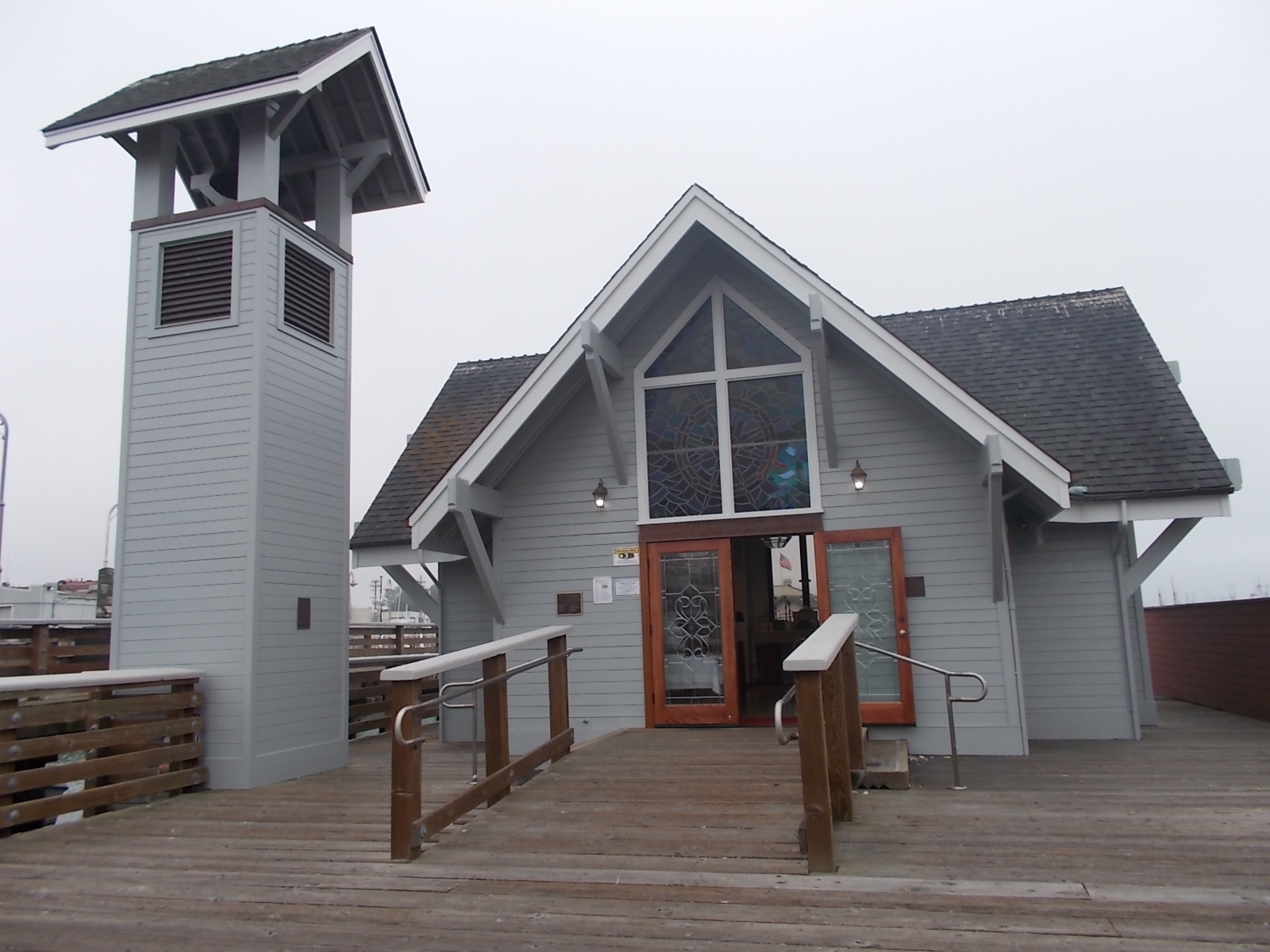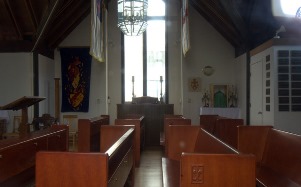
The Chapel before Installation of the Campanile



Since the early centuries of Christianity, it has been common for a community, or a wealthy local family, to fund a fishermen's and seamen's chapel. Here a Catholic priest would conduct services for the repose of the souls of the deceased fishermen and seamen. Well-known chapels of this type are to be found in Boston, Massachusetts, a favorite of Richard Cardinal Cushing, chaplain to the Kennedys; on Jersey in the British Channel Islands; and at Grimbsy, Lincolnshire, in the U.K.
Here in San Francisco, nestled between the Fishermen's Grotto and Pier 45 among the piers and fishing boats, is the Fishermen's & Seamen's Memorial Chapel, a small wood-framed chapel, brown and unimposing from a distance, but close up displaying beautiful glass windows. Built 1978-1981 and dedicated on May 21, 1981, as a memorial to the memory of fishermen and seamen who have lost their lives at sea, the modest building honors with memorial plaques some 200 fishermen and seamen who died while pursuing their ancient trade in the predominantly-Catholic fishing community.
The memorial chapel was built on the site of the old Coast Guard building, from which rescue missions to foundering vessels were once dispatched. The chapel, together with its campanile, or bell-tower, built in 2006, are the only wharf buildings added since 1950. It stands as a vibrant structure that will weather with time, as the fishermen and seamen themselves, reminding and inspiring San Franciscans and visitors alike of the rich legacy the fishermen and seamen have given us.

In 1981 the Women's Propeller Club of Northern California, a chapter of the International Propeller Club of the United States, a non-profit organization dedicated to the enhancement and well-being of all interests of the maritime community on a national and international basis, donated the stained glass window over the entry doors. The window depicts a colorful ship's wheel reminding us that God is the pilot of our life.

Hanging above the center of the chapel is the crystal Rosary Chandelier, containing fifteen candelabra lights to illuminate the chapel. The number fifteen represents the number of Mysteries of the Most Holy Rosary, associated with the Blessed Virgin Mary, venerated at the chapel under her title, Madonna del Lume (Madonna of the Light), the patron Saint of Sicilian fishermen.
On July 29, 1989, the Italian American Community of Northern California was honored by the visit of Salvatore Cardinal Pappalardo, Archbishop of Palermo, Italy, to San Francisco. During his visit the cardinal blessed this chapel and participated in a memorial service in memory of those who lost their lives at sea.
Since August 1992 the chapel has been the home of St. John's Oratory of the Society of St. John the Apostle, the only site in the San Francisco Bay Area to offer the historic fully traditional Catholic Latin Mass, Divine Office, and Gregorian Chant (1950) and other fully traditional Catholic services on Sundays and Holydays. This is the Mass at which the original Sicilian fishermen and their families would have worshipped. At every Sunday and Holyday service since 1992, public prayers have been offered for the fishermen and seamen of this port, both living and deceased, a solemn obligation that the Society has conscientiously taken on for the benefit of the fishermen and seamen of San Francisco.

In 1992 the Society of St. John the Apostle arranged for a venerable Rodgers Specification 110 Church Organ to be installed in the east nave of the chapel. This instrument, named the Catherine Baccari Memorial Organ after its donor, accompanies the chanting of the traditional Catholic Divine Office, Angelus/Regina Coeli, and monthly High Mass, offered by the Society in conjunction with the St. John Schola (small choir) for Gregorian Chant.

An antique banner above the altar depicts the Blessed Virgin Mary, who is venerated at the chapel under her title Maria Santissima del Lume (Most Holy Mary of Light), also known as the Madonna del Lume (Madonna of the Light), the patron saint of Sicilian fishermen. In Sicily, some time during the 1700s, when a group of fishermen from the small village of Ponticello lost their way at sea and prayed to the Madonna to help them find their way home, the fishermen's prayers were answered when a light suddenly appeared in the sky and guided them safely back to shore.
Ever since, the Madonna del Lume has been regarded as the patron Saint of fishermen, and Sicilians have gathered every October to pay homage to her and to honor the lives of fishermen who were lost at sea. This Catholic tradition was brought to San Francisco's North Beach by Sicilian immigrants, who arrived in the Bay Area in droves, beginning in the mid 1800s. In 1935 the Madonna del Lume Society was organized, and the first official Madonna del Lume celebration took place in 1936.
On the first Saturday in October, the day before Rosary Sunday, in a ritual practiced since mediaeval times, the words of the Blessing of Ships are intoned over the boats of San Francisco's fishing fleet, as they process out the Golden Gate:
For a detailed historical, textual, and pictorial description of the wharf area, consult Alessandro Baccari, Jr.'s 2006 San Francisco's Fisherman's Wharf. (Arcadia Publishing, 843/853-2070, sales@arcadiapublishing.com, www.arcadiapublishing.com), a 167-page, large-format paperback. Mr. Baccari donates the proceeds of all sales to the maintenance of the chapel.